Vietnam - Overseas Adventure Travel tour
February 17 - March 9, 2023
Vietnam is at the eastern edge of mainland Southeast Asia and has a population of more than 100 million, the 15th most
populous country. It shares land borders with Laos and Cambodia to the west, China to the north. The capital is Hanoi.
Ho Chi Minh City is the largest city (commonly still referred to by its former name, Saigon). It has been inhabited since the
Paleolithic age. The Han dynasty annexed northern and central Vietnam under Chinese rule starting in 111 B.C. During most of the
17th and 18th centuries, it was basically divided into 2 domains. The last imperial dynasty surrendered to France in 1883, and in
1987 its territory was integrated into French Indochina. After WWII, the Viet Minh, led by the communist revolutionary Ho
Chi Minh, launched a revolution and declared Vietnam's independence in 1945. After WWII, France tried to reclaim colonial
power in the First Indochina War, which Vietnam won in 1954. As a result of treaties between France and the Viet Minh,
Vietnam was separated into 2 parts. Shortly thereafter, the Vietnam War started between the communist North Vietnam,
supported by the Soviet Union and China, and the anti-communist South Vietnam, supported by the U.S. When the North
Vietnamese won victory in 1975, Vietnam was reunified under the Communist Party of Vietnam. An ineffective planned
economy, wars with Cambodia and China, and a trade embargo by the West, crippled the country. In 1986, the Communist
Party implemented economic and political reforms to change the country to a socialist oriented market economy. Private
ownership started to be encouraged and state enterprises operated under market constraints. Vietnam then achieved
about 8% annual GDP in the 1990s, and the U.S. ended its trade embargo. It is a developing country and has high levels
of corruption, censorship, and a poor record of human rights. The unemployment rate is 2.3%. Manufacturing, I.T., and high-
tech industries form a fast growing and large part of the economy as well as tourism. Vietnam has a state-controlled network
of schools, colleges,
and universities and also privately run and partially privatized institutions.
The national literacy rate is possibly around 90%.
Vietnam's school enrollment is amongst the highest in the world.
Page One - Northern Vietnam

We started our trip in Hanoi, the current capital. Hanoi and other cities in Vietnam are jammed with motorbikes on the streets.
Bikes are parked along the sidewalks; many are owned by workers in nearby buildings.

At Hoan Kiem Lake in the center of Hanoi. The cat was put up
as part of the celebration of the Lunar New Year. 2023 was the year of the cat in Vietnam. I walked to this area from our hotel
on my own before the tour started.

Hoan Kiem Lake is a popular area for citizens and tourists to gather to relax, chat, exercise, etc. Turtle Tower in the background.

Families out celebrating the Lunar New Year near Hoan Kiem Lake.
They had rented these little vehicles for their kids to drive around.

The kids were better drivers than many in Colorado.

The children playing in front of Ly Thai To statue, an emperor who reigned from 1010 to 1028.

Streets markets are everywhere in towns around Vietnam, and the variety of fruits and other food was amazing.

At breakfast one morning, these women visiting Vietnam from Myanmar were fascinated by
Twila's white hair and asked to take a photo with us. Twila is the one on the right, also from the Denver area (Broomfield).
Arline from Texas is in the middle.

On an orientation walk near our hotel, we stopped for a drink.
These Vietnamese men that were sitting nearby asked to take a photo with us.

On a cyclo-rickshaw ride through the old quarter of Hanoi to go to a local restaurant for dinner for the whole tour group.

Water Puppet theater in Hanoi. It is a traditional Vietnamese art form.
Puppets move through water directed by puppet handlers behind the screen.

The puppeteer

One morning some of us joined locals near Hoan Kiem Lake in doing their early morning laughing yoga.
It's a series of movements and breathing exercises and laughing on cue. The locals clearly enjoyed our joining them.

Nearby was another common early morning activity, dancing. A local woman approached Twila to help her join in the fun.
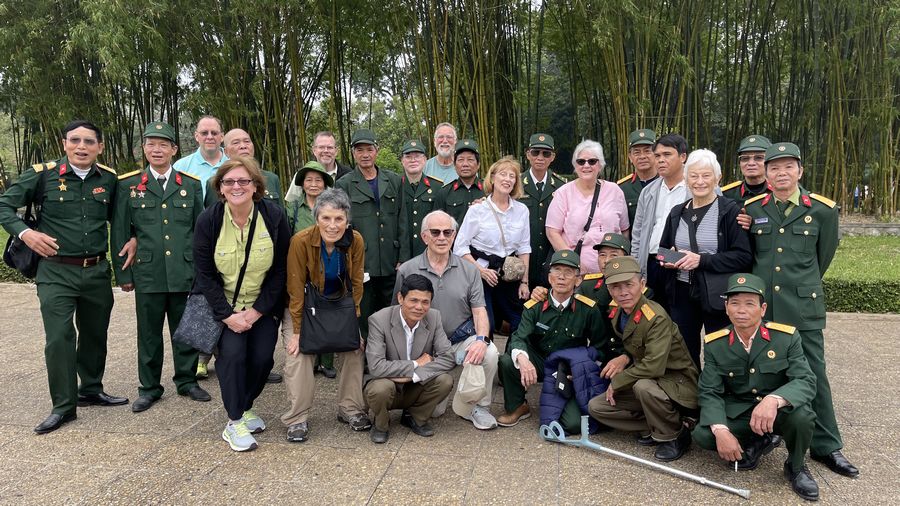
At Ho Chi Minh Mausoleum, we saw some elderly soldiers in uniform. Our guide found out they were former
Viet Cong soldiers. Someone asked to take their picture; they agreed if we would join them.
Afterward, some of the former soldiers came up to each one of us and shook our hands.

Our group in front of Ho Chi Minh Mausoleum, resting place
of the revolutionary leader and former President. His embalmed body is preserved inside.
Eugene Murphy, Lindsley Murphy, Steve Nocita, Nancy Sobeck, Jim Sobeck, Rebecca Freedman, Arline Wolters, Twila Hentz,
Karen Haas, Dan Larson, Pat Jameson

School kids visiting Ho Chi Minh Mausoleum

Children often waved to us when they saw us, and we waved back.

Female street vendor taking goods to her location, wearing traditional conical hat worn by women to protect against sun and rain.

Large variety of fish being sold at a street market in Hanoi.

At Tho Ha Village near Hanoi where we visited the home of a Vietnam war vet who fought with the Viet Cong.
He is the village chief and leader of a traditional music club.
When he found out that Dan from our group was a US Vietnam war vet, he called him up to toast.
He said we were once enemies, but now we are friends.

Hoa Lo Prison in Hanoi. Built by the French in 1896 during one of the times they controlled Vietnam.
Built to hold and torture anyone who opposed the French Govt. Later used to imprison US POWs,
who gave it the name "Hanoi Hilton." This is where John McCain was imprisoned.
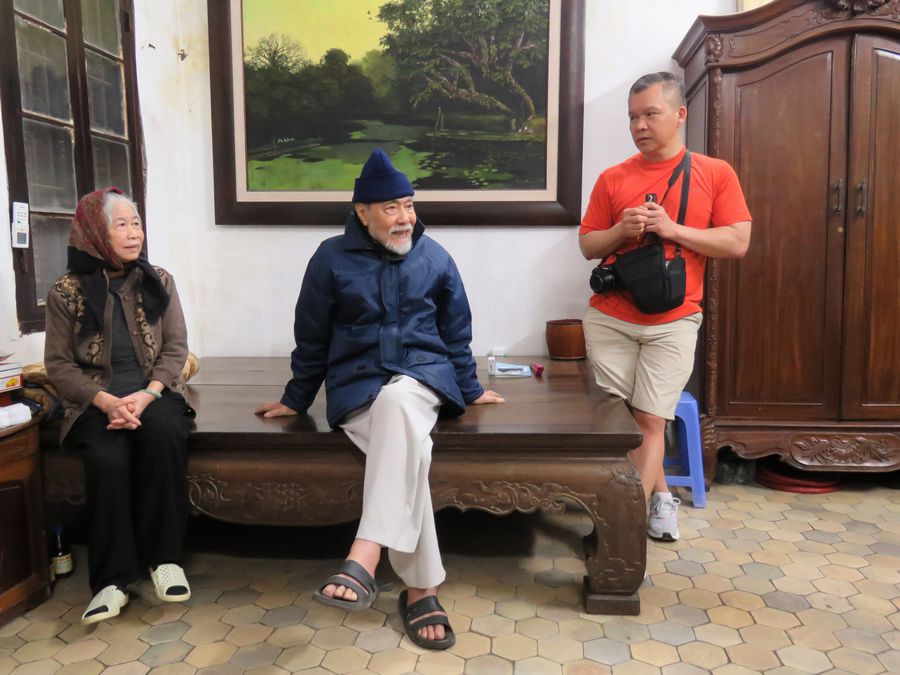
In Bat Trang, a small village near Hanoi that is known for its signature ceramic pottery. From 1954 to 1975, the northern Vietnam
communist government enforced land reform where property was seized and divided and allocated to others in an effort
to redistribute wealth.
This couple were victims of this divisive campaign.
The family had owned many properties, some of which were devoted to ceramic production.
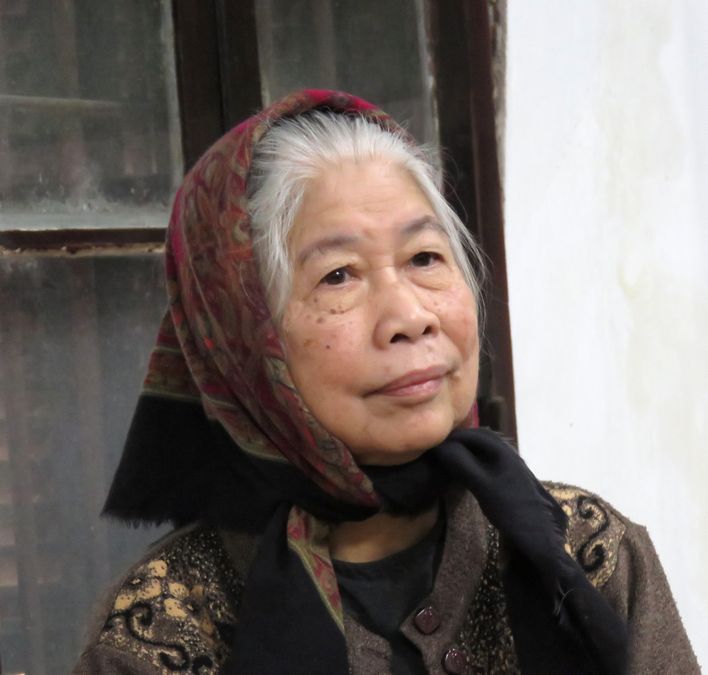
The wife. Eventually the government totally abandoned these efforts in the late 1980s.
The family got one property back, were given the equivalent of $100 for their former 13 properties,
and they returned to the family business of ceramics.

A worship area in their home

At a ceramics factory in Bat Trang.
These women were painting the ceramic pottery.

Ceramic store in Bat Trang displaying a large variety of ceramics.

Many streets in Vietnam look like this.
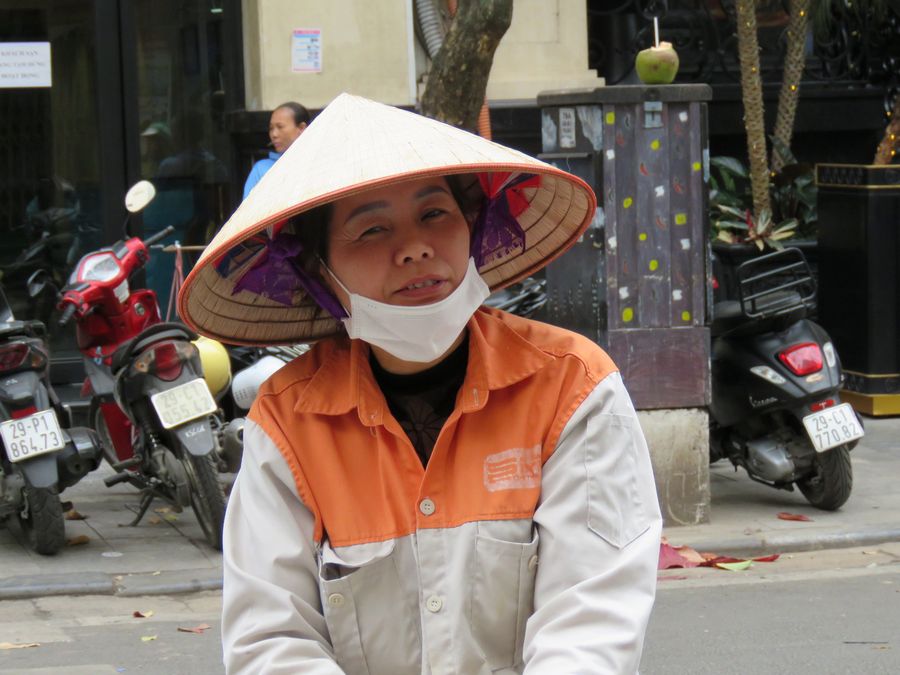
A street vendor back in Hanoi. Many people wear masks to protect against pollution and dust,
and some are wearing masks to protect against COVID.

We drove by bus from Hanoi to Halong Bay and took an overnight cruise there.
The first day, we saw this cave filled with unusual rock formations including stalactites and stalagmites.


View of part of Halong Bay from our boat.
Resting across the Gulf of Tonkin near the Chinese border, the bay is dotted with more than 1,600 mountain islands.

Many Vietnamese in Halong Bay engage in harvesting and fishing.
Flat-bottomed and oar propelled fishing boats, sampans, abound. Many such boats are occupied by entire families.

We saw numerous monkeys while taking a small boat ride around some islands.

The monkeys clearly had been fed to promote tourism.


Early morning view of Halong Bay from the deck of our boat.

Halong Bay
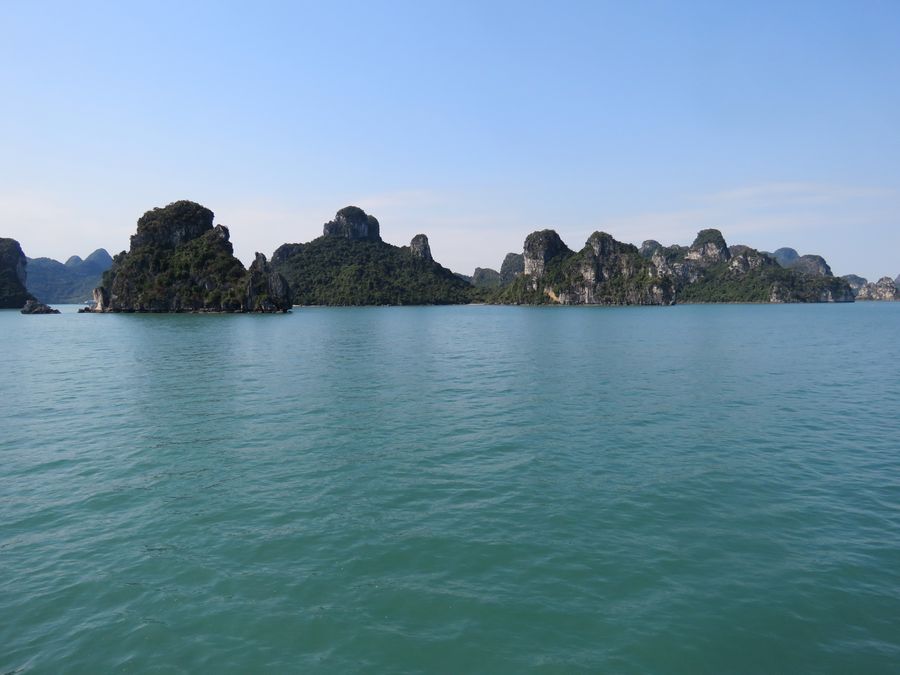


One of the staff on our boat showed us food art.
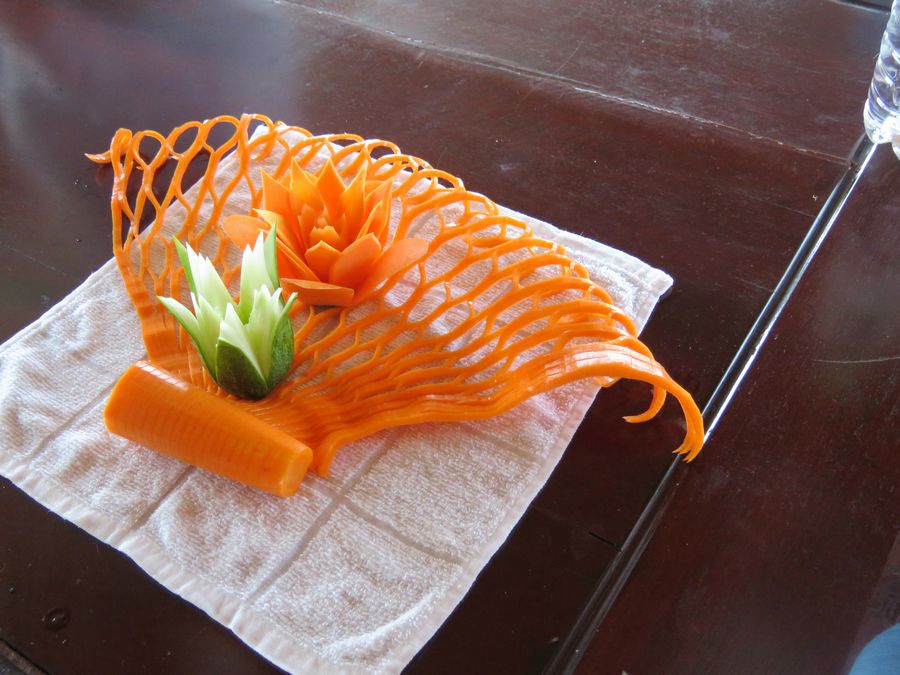
Here is his final product.
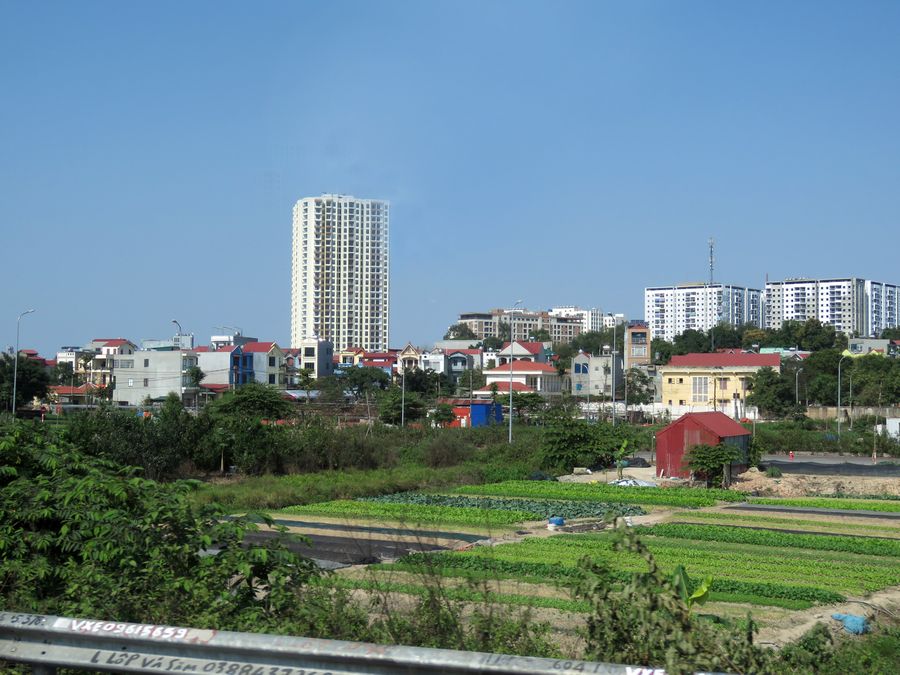
Arriving in the city of Hue by bus after driving by bus from Halong Bay back to Hanoi to catch a flight to the city of Hue.
Link to Page Two - Central Vietnam
Pat's Home Page